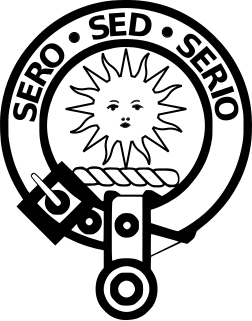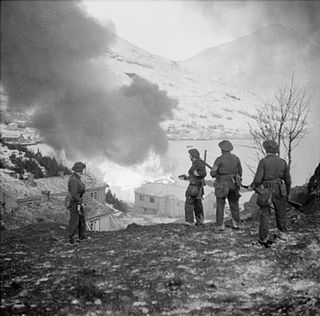
Hawick is a town in the Scottish Borders council area and historic county of Roxburghshire in the east Southern Uplands of Scotland. It is 10 miles (16.1 km) south-west of Jedburgh and 8.9 miles (14.3 km) south-south-east of Selkirk. It is one of the farthest towns from the sea in Scotland, in the heart of Teviotdale, and is the biggest town in the former county of Roxburghshire. The town is at the confluence of the Slitrig Water with the River Teviot.

Year 1514 (MDXIV) was a common year starting on Sunday of the Julian calendar.

The Battle of Flodden, Flodden Field, or occasionally Branxton, was a battle fought on 9 September 1513 during the War of the League of Cambrai between the Kingdom of England and the Kingdom of Scotland, resulting in an English victory. The battle was fought near Branxton in the county of Northumberland in northern England, between an invading Scots army under King James IV and an English army commanded by the Earl of Surrey. In terms of troop numbers, it was the largest battle fought between the two kingdoms.

Border reivers were raiders along the Anglo-Scottish border from the late 13th century to the beginning of the 17th century. They included both Scottish and English people, and they raided the entire border country without regard to their victims' nationality. Their heyday was in the last hundred years of their existence, during the time of the House of Stuart in the Kingdom of Scotland and the House of Tudor in the Kingdom of England.

Clan Kerr is a Scottish clan whose origins lie in the Scottish Borders. During the Middle Ages, it was one of the prominent border reiver clans along the present-day Anglo-Scottish border and played an important role in the history of the Border country of Scotland.

The Lawrence Massacre, also known as Quantrill's raid, was an attack during the American Civil War (1861–65) by Quantrill's Raiders, a Confederate guerrilla group led by William Quantrill, on the Unionist town of Lawrence, Kansas, killing around 150 unarmed men and boys.

The Long Ships or Red Orm is an adventure novel by the Swedish writer Frans G. Bengtsson. The narrative is set in the late 10th century and follows the adventures of the Viking Röde Orm - called "Red" for his hair and his temper, a native of Scania. The book portrays the political situation of Europe in the later Viking Age, Andalusia under Almansur, Denmark under Harald Bluetooth, followed by the struggle between Eric the Victorious and Sven Forkbeard, Ireland under Brian Boru, England under Ethelred the Unready, and the Battle of Maldon, and then the Byzantine Empire and its Varangian Guard, Kievan Rus and its neighbors the Patzinaks - all before the backdrop of the gradual Christianization of Scandinavia, contrasting the pragmatic Norse pagan outlook with the exclusiveness of Islam and Christianity.

Michael, popularly known as Great Michael, was a carrack or great ship of the Royal Scottish Navy. She was the largest ship built by King James IV of Scotland as part of his policy of building a strong Scottish navy.

A common riding is an equestrian tradition mainly in the Scottish Borders in Scotland. Male and female riders ride out of the town and along its borders to commemorate the practice from 13th and 15th centuries where there were frequent raids on the Anglo-Scottish border known as the Border Reivers and also to commemorate the Scottish defeat at the Battle of Flodden. Today, the common ridings, rideouts, or riding of the marches continue to be annual events celebrated in the summer in the Borders of Scotland. Each town may have many rideouts over their festival week, usually having one on festival day. Some towns re-enact historic 'common ridings' – although many others have well-established 'festival rides' that are cemented within their town's history. The common riding towns are: Berwick-upon-Tweed, Hawick, Selkirk, Langholm, Jedburgh, Coldstream, Penicuik,West Linton, Lanark, Lauder, Edinburgh, Melrose, Musselburgh, Galashiels, Duns, Sanquhar, and Peebles.

The 1704 Raid on Deerfield occurred during Queen Anne's War on February 29 when French and Native American forces under the command of Jean-Baptiste Hertel de Rouville attacked the English frontier settlement at Deerfield, Massachusetts, just before dawn. They burned part of the town and killed 47 villagers. The raiders left with 112 settlers as captives, whom they took overland the nearly 300 miles to Montreal. Some died or were killed along the way because they couldn't keep up. Some 60 persons were later ransomed by family and community. Others were adopted by Mohawk families at Kahnawake and became assimilated into the tribe. In this period, the English and their Indian allies were involved in similar raids against French villages along the northern area between the spheres of influence.

Teribus ye teri odin or teribus an teriodin is popularly believed to have been the war cry of the men of Hawick at the Battle of Flodden, and still preserved in the traditions of the town. In 1819, James Hogg wrote a border ballad with the same name.
Carter Bar is a point on the England–Scotland border, in the Scottish Borders and Northumberland.

Raiding, also known as depredation, is a military tactic or operational warfare mission which has a specific purpose. Raiders do not capture and hold a location, but quickly retreat to a previous defended position before enemy forces can respond in a coordinated manner or formulate a counter-attack. A raiding group may consist of combatants specially trained in this tactic, such as commandos, or as a special mission assigned to any regular troops. Raids are often a standard tactic in irregular warfare, employed by warriors, guerrilla fighters or other irregular military forces. Some raids are large, for example the Sullivan Expedition.

Stichill is a village and civil parish in the historic county of Roxburghshire, a division of the Scottish Borders. Situated 2 miles (3.2 km) north of the Burgh of Kelso, Stichill lies north of the Eden Water and 5 miles (8.0 km) from the English Border at Coldstream.

The Great Raid of 1840 was the largest raid ever mounted by Native Americans on white cities in what is now the United States. It followed the Council House Fight, in which Republic of Texas officials attempted to capture and take prisoner 33 Comanche chiefs who had come to negotiate a peace treaty, killing them together with two dozen of their family and followers. The Comanche tribe was supposed to have brought white hostages as their part of the negotiations but only brought one young woman. Arguments and fighting then broke out among the Texans and Comanches. The Texas Officials were determined to force the Comanche to release all white captives among them. To avenge what the Comanche viewed as a bitter betrayal by the Texans, the Comanche war chief Buffalo Hump raised a huge war party of many of the bands of the Comanche, and raided deep into white-settled areas of Southeast Texas.
Events from the 1510s in England.
Robert Maxwell, 5th Lord Maxwell was a member of the Council of Regency (1536) of the Kingdom of Scotland, Regent of the Isle of Arran and like his father before him patriarch of the House of Maxwell/Clan Maxwell. A distinguished Scottish nobleman, politician, soldier and in 1513 Lord High Admiral, Lord Maxwell was a member of James V of Scotland's royal council and served as Lord Provost of Edinburgh in 1524, 1527 and 1535. He was also an Extraordinary Lord of Session in 1533. In 1537, he was one of the ambassadors sent to the French Court to negotiate the marriage of James to Mary of Guise, whom he espoused as proxy for the King.

Sir James Douglas, 7th of Drumlanrig, (1498–1578) was a Scottish nobleman active in a turbulent time in Scotland's history.
Events from the year 1914 in Scotland.
William Francis Beattie R.F.A. MC was a Scottish sculptor killed in the closing weeks of the First World War. His most famous work is the 1514 Memorial in Hawick: a memorial to Hawick Callants killed in a skirmish at Hornshole in the aftermath battle following the Battle of Flodden.














